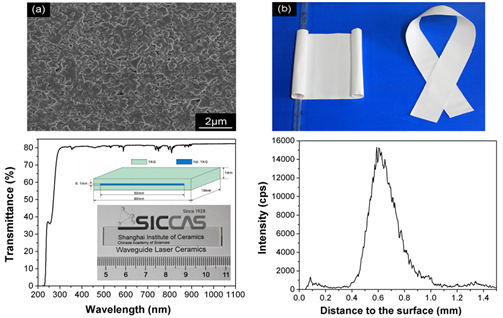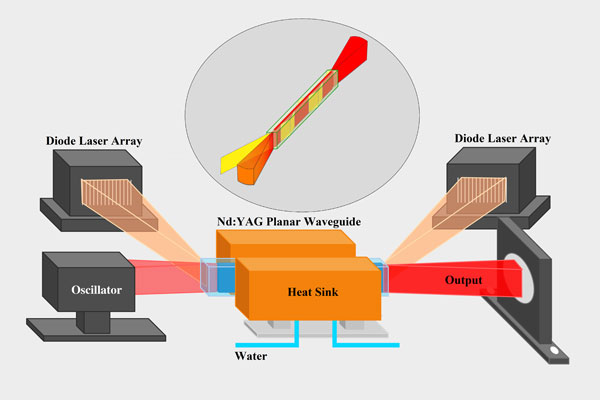

Laser diode pumping is a key factor in enabling high efficiency, scaling laser-output power while maintaining high beam quality necessitates improvements in the geometry of the gain medium itself. Due to the fact that lasers are not entirely efficient, significant amounts of waste heat are generated in the gain medium during laser operation. This waste heat can create distortions in the gain medium, adversely affecting important properties of the laser beam. The laser host utilizing planar waveguide materials as gain media has advantages in combining high output of bulk solid-state lasers and high efficiency of fiber lasers. Bonding is a common technology to realize planar waveguide laser gain media. However, planar waveguide materials with large aspect ratio still have some problems, such as uncontrollable thickness of the core layer and weak bonding strength.
Ceramic planar waveguide laser ceramic, as the evolution of laser ceramic slab, has high aspect ratio sandwich-type structure consisting of a high-index active core surrounded by lower index claddings. The guiding structure promotes high pump absorption efficiency. The high aspect ratio offers a large surface-area-to-volume ratio for efficient cooling and a high power loading limit. Planar waveguide laser ceramics can not only transmit the waste heat generated by lasing to avoid the thermal lens effect, but also increase the light density in gain media. And finally laser oscillations with low threshold and high output can be realized. Tape casting technology, which offers high precision and excellent controls of film thickness and composition, can overcome the difficulties of bonding. In 2014, high quality planar waveguide YAG/Nd:YAG/YAG transparent ceramics were fabricated by tape casting and vacuum sintering technology for the first time in the world. The in-line transmittance of the ceramic sample was over 84 percent at the lasing wavelength of 1064nm. The related work has been published in the journal of Optical Materials Express (2014, 4: 1042-1049).


Recently, high quality planar waveguide YAG/Nd:YAG/YAG ceramics were developed by Prof. Li Jiang’s group at the Shanghai Institute of Ceramics, Chinese Academy of Sciences(CAS) and tested as laser gain media by the research group led by Prof. Gao Qingsong at the Institute of Applied Electronics, China Academy of Engineering Physics. A single-pulse energy of 327 mJ at a repetition rate of 100 Hz was obtained. To the best of the researchers' knowledge, this is the highest output energy ever reported with such good beam quality achieved with ceramic YAG/Nd:YAG/YAG planar waveguides fabricated by non-aqueous tape casting and solid-state reactive sintering. This work was published in Chin. Opt. Lett. (2016, 14: 051404) as a Cover Story. And it was also reported on web of Optical Society of America (OSA) titled YAG/Nd:YAG/YAG ceramic planar waveguide laser amplifier with 327-mJ output at 100-Hz repetition rate (https://www.osapublishing.org/china/news/spot-yagcpwla.inc.cfm#chinese).
The experimental configuration of the Nd:YAG planar waveguide laser consists of three parts: the seeder, beam coupling system, and amplifier. The seeder used in this study was a Nd:YAG laser resonator. The dimensions of the laser medium were 1 mm ×10 mm × 60 mm. The ceramic YAG/Nd:YAG/YAG waveguide structure was formed in the thickness direction, and each end had an undoped YAG end cap. The pump beam from the diode laser array was launched into the planar waveguide from the end facet at a particular angle. A seeder laser was coupled from one end and amplified for a single pass. Commenting on this development, Prof. Gao Qingsong noted, "Besides the merits of high energy and high efficiency, its extremely small size enables miniaturization and lightweight design of laser systems. So, the ceramic planar waveguide laser is one of the future directions of development of high-energy all-solid-state lasers."
Related work on ceramic YAG/Nd:YAG/YAG planar waveguide laser has been reported on the website of the Optical Society of America (OSA).